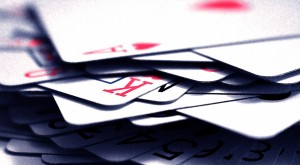Main Body
Memory Magic
Click play on the following audio player to listen along as you read this section.

Dave Farrow is a Canadian recorded in the Guinness Book of World Records for Greatest Memory. As a student, Dave had a learning disability called dyslexia. He found ways to improve his memory in order to do well in school despite his struggles with reading and writing. In 2008, he set a world record by memorizing the order of 59 decks of playing cards in two days.
How did his brain store all this information? Dave says anyone’s brain can do it, but it helps to understand how memory works. Your brain is constantly taking in information through your senses. The information enters your sensory memory, which can hold lots of information, but only for a few seconds. If you ignore the information, your brain throws it away. If you pay attention to the information, it goes into your short-term memory. This is why learning to pay attention is an important first step. To help the brain focus, Dave recommends breaking big tasks down into smaller tasks. He sets a timer and works as hard as he can for short periods of time until the timer goes off. Then he takes a small break. This keeps his focus strong.
Your short-term memory can only hold information for 15 seconds to a few minutes. In addition, short-term memory can only hold about seven things at a time. Memory champions like Dave have to hold long lists of information in their short-term memory at one time. To do this, they use different tricks.
One trick is to look at the first letter of each word in the list you want to memorize. Then, make a word or phrase using all those letters. This is called an acronym. For example, if you want to remember all the colours in the rainbow, try remembering the name Roy G. Biv. Each letter in Roy G. Biv matches the first letter of a colour: red, orange, yellow, green, blue, indigo, violet. When you want to remember the colours of the rainbow, just think of Roy G. Biv and you will have an easier time.

Another trick is to organize information into chunks. For example, when you try to remember a telephone number, your brain usually remembers it in chunks. You remember the area code as one chunk, the next three numbers as a chunk, and the final four numbers as a chunk. This way, your brain only has to remember three things instead of 10. This works for words as well as numbers. Say you want to improve your vocabulary. When you learn a new word, study words that share the same meaning. This way, you learn several new words at one time and you only need to memorize one definition. This is called a synonym. For example, these words mean big: huge, enormous, gigantic, large, and massive.
A third memory trick is to use visualization. Say you want to memorize how people developed from wormlike creatures into human beings. First, create a picture in your mind for each stage (I can see a worm, a fish, a monkey, and a human). Then, think of a path you regularly walk along. For example, I often walk from the sidewalk, into my house, and into the kitchen. Finally, imagine each picture in a place along your path. For instance, in the garden I can see a worm. Beside the garden is a garbage can. I imagine the garbage can is full of rainwater and inside I can see a fish. I go in the house, and the first door goes into a bedroom. I can see a monkey jumping on the bed. Next to the bedroom is the kitchen. My partner, a human, is cooking dinner. If I visualize that path a few times, I’ll have the information memorized. Visualization works because the brain remembers images well, and the wackier the image is, the easier it is to remember.
If you don’t keep using the information, your brain throws it away. If you keep reviewing the information, it will go into your long-term memory. The more you practice recalling the information, the better you will be at remembering it. Try these tips the next time you need to remember a phone number, a new word, or something for school.
Attributions
Playing cards
Image by gepharts3d is in the public domain.
Dave Farrow
Dave Farrow by Zacharylim is used under a CC BY SA 4.0 license.

